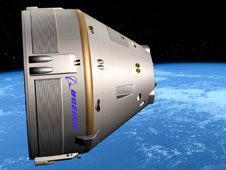NASA, SpaceX, and the Future of the U.S. Space Program
""){ ?> By Surf-D
A NASA Oct. 31st press release announced that The Boeing Co. will set up Orbiter Processing Facility-3 (OPF-3) at NASA’s Kennedy Space Center in Florida to manufacture and assemble its CST-100 spacecraft for launches to the International Space Station. This comes in the wake of discussions on the future of U.S. space program.
“It’s a clear sign that NASA will continue to be an engine for growth,” said Lori Garver, the agency’s deputy administrator, in announcing the deal during a ceremony at Kennedy’s OPF-3. “Together we’re going to win the future right here.”
The deal is expected to produce 550 jobs by 2015.
Instead of “occupying Wall Street,” people will be “occupying space stations”… not only U.S. astronauts, traveling on U.S. built and operated vehicles, but private researchers and tourists with a choice of orbital destinations, said Garver last week at the International Symposium for Personal and Commercial Spaceflight.
NASA also announced that it plans to build a new heavy-lift rocket called the Space Launch System as well as a deep-space crew capsule called the Multipurpose Crew Vehicle. The intent is to travel first to an asteroid, and then to Mars. Here’s a concept video of the Space Launch System:
If NASA is going to continue into the future, the commercial space industry needs to succeed, Garver said. She said the private industry for space travel must take over demand for transportation to low-Earth orbit and the International Space Station. NASA has requested $850 million for the project in 2012, hoping to reduce the need for Russian spacecraft by 2016 to reach the International Space Station.
Meanwhile, Space Exploration Technologies (SpaceX) announced it has successfully completed the preliminary design review of its launch abort system, a system designed for manned missions using its Dragon spacecraft. A SpaceX press release claims this represents a major step toward creating an American-made successor to the Space Shuttle.
Popular Mechanics reports, however, that if NASA doesn’t change the terms in the draft version of its contract to build a spacecraft that can deliver astronauts to orbit, then Space Exploration Technologies Corp. (SpaceX) may simply bow out of building one for NASA. “We may not bid on it,” SpaceX founder Elon Musk said. Musk said he is increasingly optimistic that the agency will change some of the rules that dictate the design.
SpaceX is designing its Dragon spacecraft to carry seven crew members seated in two rows, Musk said during recent testimony in front of the House Committee on Science, Space and Technology. The seats will be conformal and a mechanical force accommodation system will cushion any off-nominal landing impacts to assure crew safety. The crew will wear spacesuits to protect them from any rapid cabin depressurization emergency event.
Musk’s frustration is over the first draft of a contract called the CCIDC (Commercial Crew Integrated Design Contract), which NASA issued last month to guide the way that private companies build crew-carrying spacecraft.
Musk discusses SpaceX and his vision of the Falcon-9 spaceflight launch system and Dragon spacecraft in this video interview by Translogic:
“What matters is rapid and complete reusability,” says Musk. “You don’t change the wings out on an aircraft between flights.” “In a normal flight, you don’t expect to so anything except change fuel and add passengers…” Musk says he expects to get people into space within three years, and to Mars “as soon as 10 years.” Will the Russians get there first? Musk says no, that they aren’t really trying. He says that he sees China as his only real competitor.
Where does this leave NASA? “Well, in general, the government is not the best entity to do any kind of optimization or efficiency.” “As soon as you’re talking about wanting to rapidly innovate on technology and high efficiency, that’s where the private sector is best.”
Whether it’s the government, the private sector, or the “partnership†envisioned by NASA’s Lori Garver, huge new markets (and potentially hundreds of thousands of jobs) are at stake. Could Elon Musk become the Steve Jobs of the space industry? Can the U.S marshal another Kennedy Era push to space? Or, will the spoils go to the Chinese?


